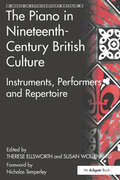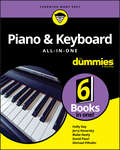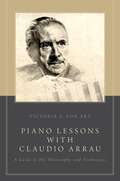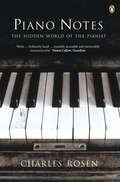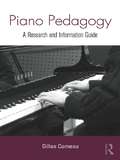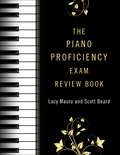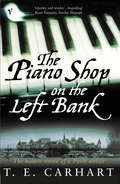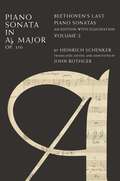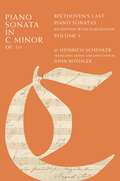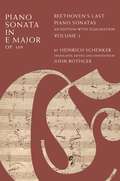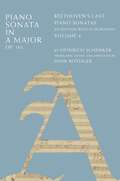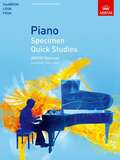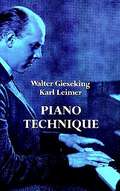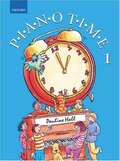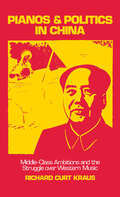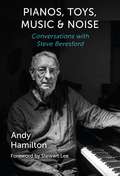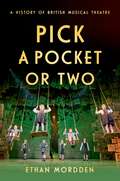- Table View
- List View
The Piano in Nineteenth-Century British Culture: Instruments, Performers and Repertoire
by Susan WollenbergSince the publication of The London Pianoforte School (ed. Nicholas Temperley) twenty years ago, research has proliferated in the area of music for the piano during the late eighteenth and nineteenth centuries and into developments in the musical life of London, for a time the centre of piano manufacturing, publishing and performance. But none has focused on the piano exclusively within Britain. The eleven chapters in this volume explore major issues surrounding the instrument, its performers and music within an expanded geographical context created by the spread of the instrument and the growth of concert touring. Topics covered include: the piano trade and how piano manufacturing affected a major provincial town; the reception of Bach's Well-Tempered Clavier and Clementi's Gradus ad Parnassum during the nineteenth century; the shift from composer-pianists to pianist-interpreters in the first half of the century that triggered crucial changes in piano performance and concert structure; the growth of musical life in the peripheries outside major musical centres; the pianist as advocate for contemporary composers as well as for historical repertory; the status of British pianists both in relation to foreigners on tour in Britain and as welcomed star performers in outposts of the Empire; marketing forces that had an impact on piano sales, concerts and piano careers; leading virtuosos, writers and critics; the important role played by women pianists and the development of the recording industry, bringing the volume into the early twentieth century.
Piano & Keyboard All-in-One For Dummies
by Holly Day Jerry Kovarsky Blake Neely David Pearl Michael PilhoferYour complete guide to playing the keys Making beautiful music on a keyboard or piano requires some know-how and practice. This book offers guidance on how to get the most out of your time learning to play the keys. With six hands-on books wrapped up in one, you'll get a deep guide to the techniques the pros use. Discover the details of music theory and reading music, explore different musical genres, and use practice exercises to improve quickly. You'll even find tips on using electronic keyboard technology to enhance your sound. Inside… Piano & Keyboard 101 Understanding Theory and the Language of Music Beginning to Play Refining Your Technique and Exploring Styles Exercises: Practice, Practice, Practice Exploring Electronic Keyboard Technology
Piano & Keyboard All-in-One For Dummies
by Michael Pilhofer Holly Day David Pearl Blake Neely Jerry KovarskyYour complete guide to playing the keys Making beautiful music on a keyboard or piano requires some know-how and practice. This book offers guidance on how to get the most out of your time learning to play the keys. With six hands-on books wrapped up in one, you'll get a deep guide to the techniques the pros use. Discover the details of music theory and reading music, explore different musical genres, and use practice exercises to improve quickly. You'll even find tips on using electronic keyboard technology to enhance your sound. Inside… Piano & Keyboard 101 Understanding Theory and the Language of Music Beginning to Play Refining Your Technique and Exploring Styles Exercises: Practice, Practice, Practice Exploring Electronic Keyboard Technology
Piano Lessons with Claudio Arrau: A Guide to His Philosophy and Techniques
by Victoria A. von ArxPiano Lessons with Claudio Arrau provides an insider's view of the art of piano performance as exemplified by one of the great artists of the twentieth century. Chilean pianist Claudio Arrau devoted his life to the piano and its music. As a child prodigy, he gained national recognition from government officials in Chile, including President Pedro Montt, who funded Arrau's education in Germany. Arrau studied in Berlin with Martin Krause, a pupil of Franz Liszt, and later immigrated to New York City where he taught and mentored a sizeable group of pupils while at the same time managing an international performing career. Arrau's profound musical insight and unique style of teaching inspired his pupils and motivated them to teach his principles to the next generation of students. This in-depth study of Arrau's principles and philosophy of technique and performance draws on information from published interviews with Arrau, from numerous interviews with Arrau's pupils, and from the author's experience in studying piano with two of them. Transcripts of actual lessons given by Arrau and preserved on tape present in his own words a detailed account of his technical and interpretive ideas about five major works of the piano repertory. References to over one hundred examples from Arrau's filmed recordings enable readers to observe the elements of Arrau's famed technique in action.
Piano Lessons with Claudio Arrau: A Guide to His Philosophy and Techniques
by Victoria A. von ArxPiano Lessons with Claudio Arrau provides an insider's view of the art of piano performance as exemplified by one of the great artists of the twentieth century. Chilean pianist Claudio Arrau devoted his life to the piano and its music. As a child prodigy, he gained national recognition from government officials in Chile, including President Pedro Montt, who funded Arrau's education in Germany. Arrau studied in Berlin with Martin Krause, a pupil of Franz Liszt, and later immigrated to New York City where he taught and mentored a sizeable group of pupils while at the same time managing an international performing career. Arrau's profound musical insight and unique style of teaching inspired his pupils and motivated them to teach his principles to the next generation of students. This in-depth study of Arrau's principles and philosophy of technique and performance draws on information from published interviews with Arrau, from numerous interviews with Arrau's pupils, and from the author's experience in studying piano with two of them. Transcripts of actual lessons given by Arrau and preserved on tape present in his own words a detailed account of his technical and interpretive ideas about five major works of the piano repertory. References to over one hundred examples from Arrau's filmed recordings enable readers to observe the elements of Arrau's famed technique in action.
Piano Notes: The Hidden World of the Pianist
by Charles RosenIn this eloquent, intimate exploration of the delights and demands of the piano, world-renowned concert pianist and music writer Charles Rosen draws on a lifetime's wisdom to consider every aspect of the instrument: from what makes a beautiful sound to suffering from stage fright, from the physical challenges of playing to tales of great musicians, including Vladimir Horowitz's recording tricks, Rachmaninov's hands and why Artur Rubenstein applied hairspray to the keys. Gracefully blending anecdote, history, expertise and memoir, Piano Notes will enchant anyone with a passion for music.
Piano Pedagogy: A Research and Information Guide (Routledge Music Bibliographies)
by Gilles ComeauPiano Pedagogy: A Research and Information Guide provides a detailed outline of resources available for research and/or training in piano pedagogy. Like its companion volumes in the Routledge Music Bibliographies series, it serves beginning and advanced students and scholars as a basic guide to current research in the field. The book will includes bibliographies, research guides, encyclopedias, works from other disciplines that are related to piano pedagogy, current sources spanning all formats, including books, journals, audio and video recordings, and electronic sources.
Piano Pedagogy: A Research and Information Guide (Routledge Music Bibliographies)
by Gilles ComeauPiano Pedagogy: A Research and Information Guide provides a detailed outline of resources available for research and/or training in piano pedagogy. Like its companion volumes in the Routledge Music Bibliographies series, it serves beginning and advanced students and scholars as a basic guide to current research in the field. The book will includes bibliographies, research guides, encyclopedias, works from other disciplines that are related to piano pedagogy, current sources spanning all formats, including books, journals, audio and video recordings, and electronic sources.
The Piano Player of Budapest: A True Story of Holocaust Survival, Music and Hope
by Roxanne de BastionOne man, his piano and their miraculous survival.'Extraordinary' Baroness Julia Neuberger'Stunning. A beautiful blend of action, poetry, thought-provoking comment and music ... just brilliant' James Ainscough OBE'A gripping narrative of suffering, loss and survival, with music at its heart' Fiona MaddocksAll future, freedom and success lay ahead of young pianist Stephen de Bastion in 1930s Hungary. Life whirled headily around cocktails, romance, applause and the buzz of Budapest late into the night. Then, 1939. Stephen's world disintegrates and this becomes a story of his brutal descent, of his time in labour camps, of Mauthausen and Gunskirchen and the unimaginable horrors he endured during the Holocaust as a man of Jewish descent. Yet, this is also a tale of extraordinary escape ... and the piano, waiting for him.The same piano that Roxanne de Bastion, his granddaughter, inherits when her father dies. It has been in the family over one hundred years but it is only when, deep in grief, she discovers a cassette recording of Stephen, that the astonishing history of the piano, the man and her family begins to unravel. Weaving together his original recordings, unpublished memoirs, letters and documents, Roxanne sings out her grandfather's story of music and hope, lost and found. Luminous and profoundly moving, this book captures the great spirit of one man in the face of darkness and the hope that echoes down through generations.
The Piano Proficiency Exam Review Book
by Lucy Mauro Scott BeardWritten with busy music majors in mind, The Piano Proficiency Exam Review Book provides an easy-to-understand guide to the Piano Proficiency Exam. In eight review sections, authors and Peabody Institute alumni Lucy Mauro and Scott Beard provide an invaluable cache of tips, exercises, and practice exams. The sections address all aspects of piano performance for the non-piano music major: seating, arm, and hand positions; scales and arpeggios; cadences; vocal warmups; harmonization/transposition; score reading; and solo literature. While studying the book, students can expect to ask themselves, "Am I at the proper distance from the piano?" and, "Are my wrists level with the white keys?" among other gentle reminders that encourage mindfulness and positivity at the piano bench. Whether adapted for a school's exam requirements, private lessons, music therapy sessions, or general music classes, lessons and exercises in The Piano Proficiency Exam Review Book will make time spent at the piano an enjoyable experience.
The Piano Proficiency Exam Review Book
by Lucy Mauro Scott BeardWritten with busy music majors in mind, The Piano Proficiency Exam Review Book provides an easy-to-understand guide to the Piano Proficiency Exam. In eight review sections, authors and Peabody Institute alumni Lucy Mauro and Scott Beard provide an invaluable cache of tips, exercises, and practice exams. The sections address all aspects of piano performance for the non-piano music major: seating, arm, and hand positions; scales and arpeggios; cadences; vocal warmups; harmonization/transposition; score reading; and solo literature. While studying the book, students can expect to ask themselves, "Am I at the proper distance from the piano?" and, "Are my wrists level with the white keys?" among other gentle reminders that encourage mindfulness and positivity at the piano bench. Whether adapted for a school's exam requirements, private lessons, music therapy sessions, or general music classes, lessons and exercises in The Piano Proficiency Exam Review Book will make time spent at the piano an enjoyable experience.
The Piano Shop On The Left Bank: Discovering A Forgotten Passion In A Paris Atelier
by T E CarhartT. E. Carhart, an American living in Paris, is intrigued by a piano repair shop hidden down a street near his apartment. When he finally gains admittance to the secretive world of the atelier, he finds himself in an enormous glass-roofed workshop filled with dozens of pianos. His love affair with this most magical of instruments and its music is reawakened. Packed with delicate cameos of Parisians and reflections on how pianos work and their glorious history, The Piano Shop on the Left Bank is an atmospheric and absorbing journey to an older way of life.
Piano Sonata in Ab, Op. 110: Beethoven's Last Piano Sonatas, An Edition with Elucidation, Volume 2
by Heinrich SchenkerHeinrich Schenker ranks among the most important figures in the development of western music theory in the twentieth century. His approach to the analysis of music permeates nearly every aspect of the field and continues to this day to be a topic of great interest among music theorists, historians, composers and performers. In his four volume work, Die letzen Sonaten von Beethoven: Kritische Ausgabe mit Einführung und Erläuterung (The Last Piano Sonatas by Beethoven: Critical edition with Introduction and Commentary) Schenker presented editions of Beethoven's Opp. 109, 110, 111 and 101 that were, at the time, unprecedented in their faithfulness to such authoritative sources as Beethoven's autograph manuscripts. He included a movement-by-movement and section-by-section discussion of form and content that grew increasingly penetrating from one volume to the next as the musical theory for which he is now known was developed, alongside inspired and detailed suggestions for the performance of each section of each work. In Beethoven's Last Piano Sonatas: An Edition, with Elucidation, noted Schenker scholar John Rothgeb presents the first English language edition and translation of these important works. Rothgeb builds upon Schenker's text, adding explanations of certain points in the commentary, references to corrections and other remarks entered by Schenker in his personal copies of the volumes, and graphic presentations of several passages (a practice that became standard in Schenker's own analytical work later in his career). Making these seminal works accessible to English speaking scholars and students for the first time, Beethoven's Last Piano Sonatas is an essential reference for music theorists, historians, performers, and composers alike.
Piano Sonata in C Minor, Op. 111: Beethoven's Last Piano Sonatas, An Edition with Elucidation, Volume 3
by Heinrich SchenkerHeinrich Schenker ranks among the most important figures in the development of western music theory in the twentieth century. His approach to the analysis of music permeates nearly every aspect of the field and continues to this day to be a topic of great interest among music theorists, historians, composers and performers. In his four volume work, Die letzen Sonaten von Beethoven: Kritische Ausgabe mit Einführung und Erläuterung (The Last Piano Sonatas by Beethoven: Critical edition with Introduction and Commentary) Schenker presented editions of Beethoven's Opp. 109, 110, 111 and 101 that were, at the time, unprecedented in their faithfulness to such authoritative sources as Beethoven's autograph manuscripts. He included a movement-by-movement and section-by-section discussion of form and content that grew increasingly penetrating from one volume to the next as the musical theory for which he is now known was developed, alongside inspired and detailed suggestions for the performance of each section of each work. In Beethoven's Last Piano Sonatas: An Edition, with Elucidation, noted Schenker scholar John Rothgeb presents the first English language edition and translation of these important works. Rothgeb builds upon Schenker's text, adding explanations of certain points in the commentary, references to corrections and other remarks entered by Schenker in his personal copies of the volumes, and graphic presentations of several passages (a practice that became standard in Schenker's own analytical work later in his career). Making these seminal works accessible to English speaking scholars and students for the first time, Beethoven's Last Piano Sonatas is an essential reference for music theorists, historians, performers, and composers alike.
Piano Sonata in E Major, Op. 109: Beethoven's Last Piano Sonatas, An Edition with Elucidation, Volume 1
by Heinrich SchenkerHeinrich Schenker ranks among the most important figures in the development of western music theory in the twentieth century. His approach to the analysis of music permeates nearly every aspect of the field and continues to this day to be a topic of great interest among music theorists, historians, composers and performers. In his four volume work, Die letzen Sonaten von Beethoven: Kritische Ausgabe mit Einführung und Erläuterung (The Last Piano Sonatas by Beethoven: Critical edition with Introduction and Commentary) Schenker presented editions of Beethoven's Opp. 109, 110, 111 and 101 that were, at the time, unprecedented in their faithfulness to such authoritative sources as Beethoven's autograph manuscripts. He included a movement-by-movement and section-by-section discussion of form and content that grew increasingly penetrating from one volume to the next as the musical theory for which he is now known was developed, alongside inspired and detailed suggestions for the performance of each section of each work. In Beethoven's Last Piano Sonatas: An Edition, with Elucidation, noted Schenker scholar John Rothgeb presents the first English language edition and translation of these important works. Rothgeb builds upon Schenker's text, adding explanations of certain points in the commentary, references to corrections and other remarks entered by Schenker in his personal copies of the volumes, and graphic presentations of several passages (a practice that became standard in Schenker's own analytical work later in his career). Making these seminal works accessible to English speaking scholars and students for the first time, Beethoven's Last Piano Sonatas is an essential reference for music theorists, historians, performers, and composers alike.
Piano Sonata in A Major, Op. 101: Beethoven's Last Piano Sonatas, An Edition with Elucidation, Volume 4
by Heinrich SchenkerHeinrich Schenker ranks among the most important figures in the development of western music theory in the twentieth century. His approach to the analysis of music permeates nearly every aspect of the field and continues to this day to be a topic of great interest among music theorists, historians, composers and performers. In his four volume work, Die letzen Sonaten von Beethoven: Kritische Ausgabe mit Einführung und Erläuterung (The Last Piano Sonatas by Beethoven: Critical edition with Introduction and Commentary) Schenker presented editions of Beethoven's Opp. 109, 110, 111 and 101 that were, at the time, unprecedented in their faithfulness to such authoritative sources as Beethoven's autograph manuscripts. He included a movement-by-movement and section-by-section discussion of form and content that grew increasingly penetrating from one volume to the next as the musical theory for which he is now known was developed, alongside inspired and detailed suggestions for the performance of each section of each work. In Beethoven's Last Piano Sonatas: An Edition, with Elucidation, noted Schenker scholar John Rothgeb presents the first English language edition and translation of these important works. Rothgeb builds upon Schenker's text, adding explanations of certain points in the commentary, references to corrections and other remarks entered by Schenker in his personal copies of the volumes, and graphic presentations of several passages (a practice that became standard in Schenker's own analytical work later in his career). Making these seminal works accessible to English speaking scholars and students for the first time, Beethoven's Last Piano Sonatas is an essential reference for music theorists, historians, performers, and composers alike.
Piano Sonata no. 8 "Pathetique" First movement, skeleton score (PDF)
by BeethovenThis is a musical score in Modified Stave Notation. The original file is available as .mscz format and the braille music version as .brf from mas@rnib.org.uk
Piano Specimen Quick Studies: for ABRSM Diplomas (DipABRSM, LRSM, FRSM)
by AbrsmThis title contains valuable practice material for candidates preparing for the piano quick study in ABRSM Performance and Teaching Diploma exams. The book contains 10 studies at DipABRSM level and two each for LRSM and FRSM.
Piano Technique
by Walter Gieseking Karl LeimerThe volume presents two book by Walter Gieseking, foremost pianist of his generation, and his teacher for five years, Karl Leimer, that have long been sought after by students and teachers looking for a radical approach toward developing not only finger-technique but expression-technique. Emphasis throughout is on listening to one's self and proper understanding as the basis of proper technique for the piano.In book one, originally titled The Shortest Way to Pianistic Perfection, Gieseking and Leimer work with a series of piano works -- a study from Lebert and Stark, Bach's Two- and Three-Part Inventions in C, and Beethoven's Sonata in F Minor, Op. 2, No. 1. Before beginning to play, the student is asked to visualize each piece through silent reading. Through Leimer's instruction in this area the student soon discovers how to approach each piece as not merely a series of notes to memorize but as a coherent musical structure to understand. Following are instructions on natural interpretation, with consideration of touch, relaxation, and proper emphasis in the practice. Also given are notes on such topics as etudes, scales, broken chords, the trill, and tranquility.In book two, Rhythmics, Dynamics, Pedal and Other Problems of Piano Playing, Leimer carries his method of visualization further with a study of the Allemande from Bach's French Suite in E Major. Following are further exercises and practices for developing other pianistic technique with reference to works of other composers. Specific exercises which cover rhythmics, dynamics, and phrasing are designed so that they will benefit not only the pianist but also performers on other instruments. Extensive chapters on variety of touch and the pedal give a great number of techniques and exercises for extending the expressive and dynamic range.
Piano Time 1: (pdf)
by Pauline HallPiano Time 1 starts at the very beginning, with simple five-finger tunes for hands separately and together, many with duet parts. It gradually adds more notes and techniques to cover sharps and flats, simple scales and keys, and a range of dynamics and symbols.
Pianos And Politics In China: Middle-class Ambitions And The Struggle Over Western Music
by Richard Curt KrausIn China, a nation where the worlds of politics and art are closely linked, Western classical music was considered during the cultural revolution to be an imperialist intrusion, in direct conflict with the native aesthetic. In this revealing chronicle of the relationship between music and politics in twentieth-century China, Richard Kraus examines the evolution of China's ever-changing disposition towards European music and demonstrates the steady westernization of Chinese music. Placing China's cultural conflicts in global perspective, he traces the lives of four Chinese musicians and reflects on how their experiences are indicative of China's place at the furthest edge of an expanding Western international order.
Pianos, Toys, Music and Noise: Conversations with Steve Beresford
by Andy HamiltonSteve Beresford's polymathic activities have formed a prism for the UK improv scene since the 1970s. He is internationally known as a free improviser on piano, toy piano and electronics, composer for film and TV, and raconteur and Dadaist visionary. His résumé is filled with collaborations with hundreds of musicians and other artists, including such leading improvisers as Derek Bailey, Evan Parker and John Zorn, and he has given performances of works by John Cage and Christian Marclay. In this book, Beresford is heard in his own words through first-hand interviews with the author. Beresford provides compelling insight into an extensive range of topics, displaying the broad cultural context in which music is embedded. The volume combines chronological and thematic chapters, with topics covering improvisation and composition in jazz and free music; the connections between art, entertainment and popular culture; the audience for free improvisation; writing music for films; recording improvised music in the studio; and teaching improvisation. It places Beresford in the context of improvised and related musics – jazz, free jazz, free improvisation – in which there is growing interest.
Pianos, Toys, Music and Noise: Conversations with Steve Beresford
by Andy HamiltonSteve Beresford's polymathic activities have formed a prism for the UK improv scene since the 1970s. He is internationally known as a free improviser on piano, toy piano and electronics, composer for film and TV, and raconteur and Dadaist visionary. His résumé is filled with collaborations with hundreds of musicians and other artists, including such leading improvisers as Derek Bailey, Evan Parker and John Zorn, and he has given performances of works by John Cage and Christian Marclay. In this book, Beresford is heard in his own words through first-hand interviews with the author. Beresford provides compelling insight into an extensive range of topics, displaying the broad cultural context in which music is embedded. The volume combines chronological and thematic chapters, with topics covering improvisation and composition in jazz and free music; the connections between art, entertainment and popular culture; the audience for free improvisation; writing music for films; recording improvised music in the studio; and teaching improvisation. It places Beresford in the context of improvised and related musics – jazz, free jazz, free improvisation – in which there is growing interest.
Pick a Pocket Or Two: A History of British Musical Theatre
by Ethan MorddenFrom Gilbert and Sullivan to Andrew Lloyd Webber, from Julie Andrews to Hugh Jackman, from Half a Sixpence to Matilda, Pick a Pocket Or Two is the story of the British musical: where it began and how it developed. In Pick a Pocket Or Two, acclaimed author Ethan Mordden brings his wit and wisdom to bear in telling the full history of the British musical, from The Beggar's Opera (1728) to the present, with an interest in isolating the unique qualities of the form and its influence on the American model. To place a very broad generalization, the American musical is regarded as largely about ambition fulfilled, whereas the British musical is about social order. Oklahoma!'s Curly wins the heart of the farmer Laurey--or, in other words, the cowboy becomes a landowner, establishing a truce between the freelancers on horseback and the ruling class. Half a Sixpence, on the other hand, finds a working-class boy coming into a fortune and losing it to fancy Dans, whereupon he is reunited with his working-class sweetheart, his modest place in the social order affirmed. Anecdotal and evincing a strong point of view, the book covers not only the shows and their authors but the personalities as well--W. S. Gilbert trying out his stagings on a toy theatre, Ivor Novello going to jail for abusing wartime gas rationing during World War II, fabled producer C. B. Cochran coming to a most shocking demise for a man whose very name meant "classy, carefree entertainment." Unabashedly opinionated and an excellent stylist, author Ethan Mordden provokes as much as he pleases. Mordden is the preeminent historian of the form, and his book will be required reading for readers of all walks, from the most casual of musical theater goers to musical theater buffs to students and scholars of the form.
Pick a Pocket Or Two: A History of British Musical Theatre
by Ethan MorddenFrom Gilbert and Sullivan to Andrew Lloyd Webber, from Julie Andrews to Hugh Jackman, from Half a Sixpence to Matilda, Pick a Pocket Or Two is the story of the British musical: where it began and how it developed. In Pick a Pocket Or Two, acclaimed author Ethan Mordden brings his wit and wisdom to bear in telling the full history of the British musical, from The Beggar's Opera (1728) to the present, with an interest in isolating the unique qualities of the form and its influence on the American model. To place a very broad generalization, the American musical is regarded as largely about ambition fulfilled, whereas the British musical is about social order. Oklahoma!'s Curly wins the heart of the farmer Laurey--or, in other words, the cowboy becomes a landowner, establishing a truce between the freelancers on horseback and the ruling class. Half a Sixpence, on the other hand, finds a working-class boy coming into a fortune and losing it to fancy Dans, whereupon he is reunited with his working-class sweetheart, his modest place in the social order affirmed. Anecdotal and evincing a strong point of view, the book covers not only the shows and their authors but the personalities as well--W. S. Gilbert trying out his stagings on a toy theatre, Ivor Novello going to jail for abusing wartime gas rationing during World War II, fabled producer C. B. Cochran coming to a most shocking demise for a man whose very name meant "classy, carefree entertainment." Unabashedly opinionated and an excellent stylist, author Ethan Mordden provokes as much as he pleases. Mordden is the preeminent historian of the form, and his book will be required reading for readers of all walks, from the most casual of musical theater goers to musical theater buffs to students and scholars of the form.
